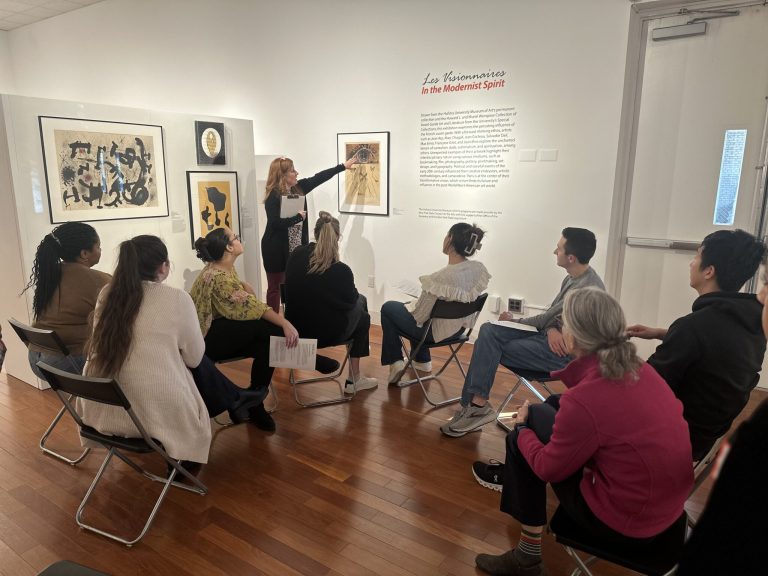
On Friday, Feb. 9 a group of second-year medical students, enrolled in the Humanities in Medicine Scholarly Concentration, from the Donald and Barbara Zucker School of Medicine at Hofstra/Northwell participated in a creative activity involving visual thinking strategies at the Hofstra University Museum of Art.
Visual thinking strategies are one of the most established and studied forms of art museum-based teaching methods and involve an open-ended facilitated discussion centered around a work of art such as a sculpture or a painting.
As part of the exercise, students observed various pieces from the museum’s current exhibition, “Les Visionnaires: In the Modernist Spirit.” and shared their thoughts as to what they saw and what they believed to be going on in the work of art based off of what they observed.
The students, who were joined by faculty advisors, Drs. Alice Fornari and Taranjeet Kalra Ahuja, shared views, debated various meanings and also reflected on their perspectives as a group.
“The visual thinking strategies activity was a welcome deviation from our usual regimented studies and I appreciated the way we went about the activity at the museum,” reflected second-year medical student, Tisheya Ward, who hails from Brooklyn. “Doing this incentivized us to think about how we can apply the same framework to other parts of our lives, and especially to practice. It’s often uncomfortable to see something and not immediately know what it’s meant to be, but the activity allowed us a space to lean into uncertainty, to make of it what we could, and to acknowledge that there are so many different ways of seeing and to further explore various perspectives.”
The activity culminates because of research exploring the arts in physician development. More specifically, art-museum-based teaching and art observation exercises have been found to improve physicians’ observation skills when interacting with patients.
Participating in such exercises has allowed physicians to widen their own scope of what they see when meeting a patient, ignore the thoughts or potential diagnoses made by others and even consider the patient’s surroundings and what that may say about them. This was also something brought up during the museum experience.
Students discussed connections to clinical practice and why it’s important to tolerate ambiguity and multiple perspectives to combat thinking programs such as over-confidence and confirmation bias.
Thus, the evidence-based approach reflects that visual thinking strategies can also benefit medical students and allow them to improve their observation skills and what they see for the first time when meeting a patient before they even officially enter practice.
“The visual thinking strategies session at the museum allows students to work together as a team and unpack a piece of art. They see and hear perspectives beyond their own and are open to accepting possibilities that were possibly unseen by them at first,” explained Taranjeet Kalra Ahuja, director of Humanism in Medicine, Communications co-leader and assistant professor of Science Education and Pediatrics at the Zucker School of Medicine and chair of Pediatrics at Planview Hospital Northwell Health. “These correlate beautifully to patient care. We all bring our lens and expertise to the bedside, and it is only when we collaborate and share ideas can we provide optimal care for our patients.”
While the visual thinking strategies activity lends itself to the development of these future physicians and correlates to skills they will use in clinical practice, it also served as a time to get away from the classroom and de-stress as they get their eyes onto the arts. “Today’s activity was relaxing and refreshing; My background is in archaeology and material culture, and I think this session reinforced skills that I have been developing for many years,” said second-year medical student Liam McGuirk, a West Nyack native. “I think the session was rewarding because it conveyed meaningful career skills using art. It made me feel more comfortable drawing conclusions and justifying my thoughts when there is truly no ‘right’ way to interpret the art.”
The Humanities in Medicine Scholarly Concentration allows Zucker School of Medicine students to undertake rigorous independent scholarship in cross-disciplinary fields of interest by studying biomedically relevant topics through the lens of the arts and humanities. Participating students benefit from faculty mentors and may have the opportunity to publish their work and/or design and implement a program that integrates medicine and the humanities. Students who successfully fulfill the program requirements earn a certificate and a designation at graduation. This collaboration between the Zucker School of Medicine and the Hofstra Museum of Art serves as an important educational lesson and a steppingstone in the careers of this cohort of HIM students.
“Simply put, visual arts are part of the humanities, so we always want to make sure that our Humanities students are exposed to the visual arts. In traditional classes that we run with sessions, it’s much harder to do that because the ideal thing is to go to the museum. So this opportunity to actually go to a museum and look at the artwork and experience it in person while also practicing these visual thinking strategies is key to helping students understand the full scope,” explained Alice Fornari, associate dean for Educational Skills Development and professor of Science Education and Family Medicine at the Zucker School of Medicine at Hofstra/Northwell and vice president of Faculty Development at Northwell Health. “Experiencing the museum in person goes beyond just looking at a picture on a PowerPoint slide. It’s much more impactful. It allows for students to get the full experience and then hopefully transfer that to the patient care when they see a patient and think, right, I must observe everything about what I’m seeing.”






